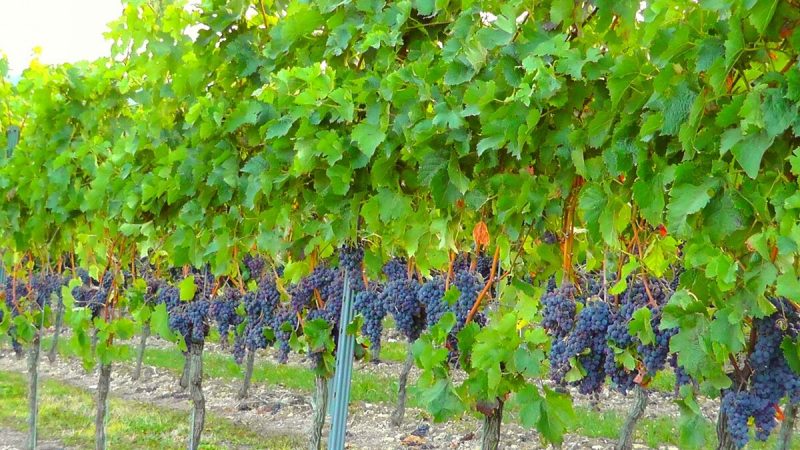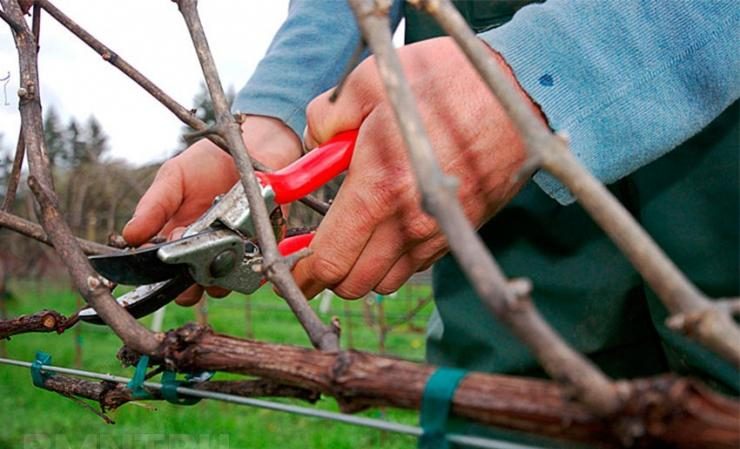Step-by-step guide to properly preparing grapes for winter
Grapes are equally tasty both fresh and canned; its berries and leaves are added to various dishes. Grape juices, jams and wines add spice to any table.
Grapes are capricious in cultivation. To get a good harvest in summer, the plant begins to cook in the fall. During the wintering period, the grapes must retain flower buds for future berries. Let's talk about the types and timing of work to prepare grapes for winter.
The content of the article
Preparation time
Vineyard care in autumn begins in September, immediately after harvest... The work continues during the autumn months and ends before the establishment of permanent frosts by covering the bushes. The preparation time depends on the region and climatic conditions.
In the south, the climate allows you to take care of plants until December. In the middle lane, work begins in September and ends in late November - early December. In northern latitudes, where the first frosts begin in September, the time for leaving is reduced.

How to prepare grapes for winter
Preparation for winter consists of several stages. In order for the bushes to give a good harvest for the next year, in the fall they carry out top dressing, pruning, provide timely watering, treat them from pests and diseases and reliably shelter from the cold.
Watering
Autumn watering is necessary for the grapes to protect the roots. The moist soil that surrounds the root system will prevent freezing.
If the plant is provided with water-charging irrigation in the fall, then in the spring it will begin the growing season earlier.
To make watering as effective as possible, first, a groove 10 cm deep is made around the plant, then water is poured into it.
The volume of water is chosen depending on the type of soil.
Light sandy soil needs 50 liters (about 5 buckets) for one bush. Chernozem and loamy soils need 25-30 liters (2.5-3 buckets) per bush.
Important! The bushes are watered in the period after pruning and falling of leaves and before the ground begins to freeze.

Top dressing
By the ripening period of the crop, the vine gives up all its strength, therefore, nutrients are introduced in the fall. Timely feeding helps to preserve the flower buds and restore the plant's vigor.
One of the most nutritious and safest remedies is humus. Rotten leaves are collected around the plant, mixed with turf, sprinkled around the bushes and dug up. Potassium fertilizers are added on top.
When planting new seedlings in the autumn, humus is first added to the planting pit.
Vine bushes love calcareous soils. Lime is quickly washed out of the soil, so it is applied regularly both in spring and autumn.
The vineyard is also fed with aqueous solutions of fertilizers. Take 10 g of an aqueous extract of potash fertilizers, 20 g of phosphoric fertilizers and dissolve in 10 liters of water. With this mixture, the soil is poured around the bushes to a depth of 25 cm.
It is useful to add a solution of trace elements to the irrigation mixture - iodine, potassium permanganate, boric acid, ammonium molybdate.
Also, wood ash is used for feeding. Take 200 g per 1 m², scatter around the bushes and slightly dug.
Nitrogen fertilizers are not applied in the autumn, as they contribute to the growth of green mass, and this leads to the freezing of the plant.
Important! If the grapes are not fertilized in the fall, spring dressings will not be able to compensate for the nutrient deficiency in the soil.
Pruning

Pruning is carried out after the foliage has fallen from the plant. It is allowed to prune the vine after the first frost, but always before the soil freezes completely. The optimal pruning month is October.
Only the unripe parts of the vine are cut off, and the ripened areas are left. Cut off the shoots at the transition point to the dry part of the vine. You can determine the ripened and unripe parts by taking the shoot in your hand. The cool wet part will be unripe, and dry and warm will mature.
Thin (less than 5 mm), damaged, diseased shoots and arrows that have borne fruit are also cut off. When two or three shoots grow from one vine, one of the strongest of them is left, and the rest are cut off.
One-year-old shoots that grow from the soil should also be removed.
Read also:
How to store potatoes in winter in a private house without a cellar.
Simple and tasty ways of salting red cabbage for the winter in jars.
Protection against diseases and pests
In autumn, grapes are preventively processed. It is necessary to protect the plant from wintering forms of pathogens and pest larvae.
In September, after harvesting, the vineyard is sprayed with insecticides to prevent pests from settling inside the wood. Experienced winegrowers advise using the effective preparation "Aktara" for these purposes.
To protect against diseases, fungicides are simultaneously used. Until the leaves have fallen off, use mild remedies. One of the best is Bordeaux blend.
When the foliage has fallen completely, the bushes are treated with urea, iron and copper sulfate. These products are applied only on the bare trunk.
All treatments are completed before the plant is sheltered for the winter.
Shelter
Grapes are a thermophilic plant. A sharp and severe cold snap leads to the death of areas of young growth. If this happens, then the next year the plant will give a weak harvest or will not bear fruit at all. Therefore, for the winter, grapes are covered before the soil begins to freeze.
Hiding bushes options
Vine bushes are covered with different materials. Some are suitable for regions with any climate, others for southern regions with warm winters.
Lapnik
If there is a coniferous forest near the site where the grapes grow, then the pine and spruce branches will be an excellent shelter for the plant. The vines are covered with spruce branches from above, the layer thickness is 30-40 cm.
This type of cover has many advantages:

- rodents do not settle in spruce branches;
- it is breathable;
- no mold and mildew;
- it takes a little time for the procedure.
Straw
Straw is an eco-friendly breathable shelter. The grapes are covered with straw twice.
The vines are laid on boards and covered with a layer of straw 20-25 cm thick. The same layer is laid in 2-3 weeks.
To prevent the straw from being blown by the wind, it is fixed with arcs or spanbond.
Also, the straw is covered with snow on top. Straw has one significant drawback - rodents often settle in it.
Snow
This type of shelter is convenient in those regions where heavy snow falls. The vines are first laid on plywood or boards and fixed with metal staples.
The height of the snow cover must be at least 50 cm, therefore, snow is poured during the winter. To prevent the snow from being blown by the wind, it is lightly compacted.
Snow cover is one of the easiest and fastest methods, but it also has disadvantages:
- with the onset of severe (up to -10 ° C) frosts before snow falls, the plant may die;
- winter thaws lead to the melting of snow and the disappearance of the shelter;
- alternating thaws and frosts lead to the death of the plant.
Earth
Ground, or turf, cover the grapes with the onset of frost. First, a layer 10 cm thick is poured, and after 3 weeks another layer of the same thickness is applied.
With this method, containers with dry soil are prepared in advance.The disadvantage is the possible freezing of the ground cover.
Roofing material
This material is used in regions with mild winters, where little snow falls.
The vines are wrapped in burlap and folded into grooves prepared on the ground. Then roofing material is laid on top. Since it is airtight, it is periodically removed for ventilation.
Important! If the grapes grow on sandy soil, you cannot add it to the ground - such soils freeze in winter.
Film
An effective way to shelter grapes in regions with mild winters. The plant is laid on the ground and iron arcs are placed on top, without fixing them. The arcs are covered with foil and sprinkled with earth along the edges. On one side, air gaps are left. With the onset of cold weather, the cracks are reliably closed.
Features of preparation depending on the grape variety
The peculiarities of preparation for winter depend on the grape variety and the age of the plant. In any climatic conditions, proper care is the key to a rich harvest.
Depending on the region
Climatic conditions in different regions make it possible to grow early and late grape varieties. Each region has its own characteristics of growing crops.
Ukraine
Ultra-early, early and late frost-resistant varieties are grown in Ukraine. Thanks to the warm climate, grapes winters without shelter or with minimal film protection.
The peculiarity of Ukrainian winters is the difference in temperatures above zero and below zero. This contributes to the appearance of ice and leads to the death of the plant, so growers prefer to cover even winter-hardy varieties.
Middle zone of Russia and Moscow region
For the middle lane, breeders have developed varieties that are resistant to the changeable climate of the region. For a relatively short summer, varieties with a short growing season - 95-120 days, manage to develop and give a harvest.
To winter in this climatic zone, grapes must withstand temperatures of -20 ° C.
Another feature is resistance to fungal infections. Wet, cool summers contribute to their spread. Special attention is paid to the prevention of infections during the autumn preparation period.
Before the shelter, the grapes are buried in earth.
Ural and Western Siberia
Hardened and frost-resistant varieties adapt well to the climate of the Urals and Siberia. In these regions, they begin to prepare the culture for winter earlier than others. Particular attention is paid to a reliable shelter for grapes. With any covering material, another 50 cm layer of snow is poured on top. They take off the shelter not earlier than April.
Nuances for young grapes
In the fall, young grapes need to ensure the ripening of the vines.
As long as the soil is still warm and contains a lot of nitrogen, the plant will continue to grow long shoots. After the soil has cooled down, the bush begins to ripen. To speed up the process, the top is removed from it. They also pinch the stepsons so that the bush does not expend energy on the growth of shoots. In this case, buds may wake up for the next year's harvest. On young bushes, this is not dangerous, since they do not yet bring a large harvest.
The treatment of a young plant from pests and diseases is carried out in the same way as all other bushes.
Several times they are sprayed with a solution of potash fertilizers.
Pruning young vines is optional. The remaining foliage is removed from them, treated with iron sulfate and laid on the ground.
Cover a young plant before the onset of the first frost. Shelter materials are used the same as for the rest of the grapes.
It is interesting:
The best ways to freeze raspberries for the winter correctly.
Conclusion
Growing grapes is not easy. The main condition for the future harvest is the correct preparation of the plant for winter. If you feed and cut the grapes in a timely manner, protect them from diseases and reliably shelter them from the cold, in the summer it will delight you with an abundance of tasty, juicy and beautiful berries.